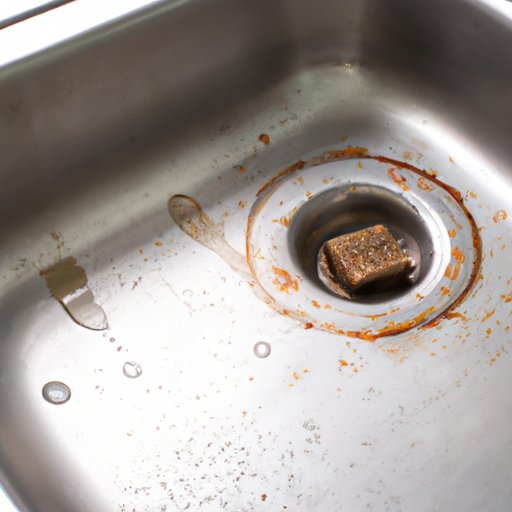
Introduction
If you’re looking for a durable and stylish sink, a stainless steel sink is a great option. However, its shining surface can easily lose its luster and become tarnished. Keeping your kitchen sink clean is important not only for its appearance but also for maintaining good hygiene. In this article, we’ll guide you through step-by-step methods for cleaning and maintaining your stainless steel sink, as well as offer natural and DIY cleaning solutions.
Step-by-step guide
Cleaning a stainless steel sink may seem daunting, but it’s a relatively simple process. The following steps will help you keep your sink looking clean and shiny:
- Remove any food scraps and debris from the sink.
- Rinse the sink with warm water.
- Apply a small amount of dish soap to the sink.
- Scrub the sink with a soft sponge, paying special attention to corners and hard-to-reach areas.
- Rinse the sink with warm water, making sure to remove all soap residue.
- Dry the sink with a clean, soft cloth or paper towel.
You should aim to clean your sink daily, or as soon as possible after use, to prevent water spots and mineral buildup.
Natural methods
If you prefer a more natural approach to cleaning your sink, there are several household items you can use to clean stainless steel sinks. One of the most effective mixtures is a cleaning paste made from baking soda and lemon juice. To make the paste, mix half a cup of baking soda and enough lemon juice to form a thick paste. Apply the paste to your sink, using a soft-bristled brush or sponge to work it in. Rinse thoroughly and dry the sink.
Vinegar is another natural cleaner that is effective on stainless steel. You can mix equal parts water and vinegar in a spray bottle and apply it to your sink. Scrub and rinse thoroughly before drying the sink. The acidic properties of vinegar can help remove water spots and mineral buildup.
Routine maintenance
In addition to daily cleaning, regular maintenance is necessary to keep your stainless steel sink looking shiny and new. The following tips can help:
- Wipe the sink dry after use to prevent water spots and mineral buildup.
- Clean your sink at least once a week to avoid buildup and stains.
- Avoid using harsh chemicals and abrasive sponges that can scratch the sink’s surface.
- Use a sink mat to protect the sink from scratches and dings.
- Avoid leaving metal items in your sink, as they can cause rust stains.
DIY cleaning solutions
There are many household items you can use to create effective DIY cleaning solutions for your stainless steel sink. Here are a few:
- Baking soda: Mix with water to create a paste and scrub the sink.
- Vinegar: Mix equal parts water and vinegar in a spray bottle and apply it to your sink.
- Hydrogen peroxide: Mix with baking soda to create a paste and scrub the sink.
- Olive oil: Apply a small amount of olive oil to your sink and buff with a soft cloth to add shine.
Using DIY cleaners is not only cost-effective, but it’s also better for the environment than store-bought cleaners that contain harsh chemicals.
How to remove stubborn stains
Despite your best efforts, your stainless steel sink may develop stubborn rust or water stains. Here are some methods for removing them:
- Baking soda and vinegar: Create a paste with baking soda and vinegar and apply it to the affected area. Allow it to sit for a few minutes before scrubbing and rinsing it off.
- Lemon juice and salt: Apply fresh lemon juice to the affected area and sprinkle salt on top. Allow it to sit for a few minutes before scrubbing and rinsing it off.
- Club soda: Soak a cloth in club soda and place it over the affected area. Let it sit for several hours to dissolve the stain before scrubbing and rinsing the area.
How to make a homemade sink cleaner
If you’re looking for an easy and effective homemade cleaner, try this recipe:
- 1 cup baking soda
- 2 teaspoons salt
- 1/2 cup liquid dish soap
- 1/2 cup water
Combine the ingredients in a bowl and stir until well mixed. Use a sponge or soft-bristled brush to apply the cleaner to your sink, scrubbing gently. Rinse well and dry the sink with a soft cloth.
How to best care for your stainless steel sink
Proper care and maintenance are crucial for keeping your stainless steel sink looking new. Here’s what you need to know:
- Clean your sink after use to prevent stains and buildup.
- Dry the sink after use to prevent water spots and mineral buildup.
- Use a sink mat to protect the sink from scratches and dings.
- Avoid using harsh chemicals and abrasive sponges that can scratch the sink’s surface.
- Avoid leaving metal items in your sink, as they can cause rust stains.
Conclusion
In conclusion, cleaning and maintaining a stainless steel sink is not as daunting as it may seem. By following these simple steps and using natural and DIY cleaning solutions, you can keep your sink looking shiny and new. Incorporating these habits into your cleaning routine can also help prevent future stains and damage to your sink.
We hope you find this guide helpful in achieving a clean and spotless stainless steel sink.




